

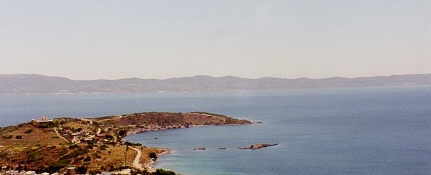 Located on Attica's eastern coast (just north of Laurion), the acropolis
of ancient Thorikos sits above the small modern community of the same name
and looks out over the Bay of Thorikos that seperates it from Laurion.
The area was known in antiquity for its mines. It was these mines which
furnished Athens with much of the basis of its power and wealth. Even
today industry still leaves its mark on the area with power and manufacturing
plants to the north. The hilly inland area of Attica drops down into
a few fertile coastal plains along its eastern coast. One of these
fertile plains was located at Thorikos and surely was part of the reason
why the Bronze Age peoples settled here.
Located on Attica's eastern coast (just north of Laurion), the acropolis
of ancient Thorikos sits above the small modern community of the same name
and looks out over the Bay of Thorikos that seperates it from Laurion.
The area was known in antiquity for its mines. It was these mines which
furnished Athens with much of the basis of its power and wealth. Even
today industry still leaves its mark on the area with power and manufacturing
plants to the north. The hilly inland area of Attica drops down into
a few fertile coastal plains along its eastern coast. One of these
fertile plains was located at Thorikos and surely was part of the reason
why the Bronze Age peoples settled here. Mycenaean Tombs
The large (and quite high) acropolis of Velatouri divides
the classical and archaic site on the south from the Mycenaean tombs to the
north. A road (not for most vehicles) climbs from the vicinity of the
Ayios Nikolaos promentory to the Mycenaean tholos tombs near the summit.
The Mycenaean kings of the area are supposedly linked to Athens since King
Kephalos married the daughter of Erechtheus, Prokris.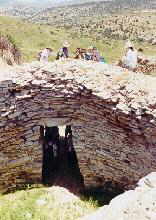 The best preserved tomb, Tholos B, measures 9.25
The best preserved tomb, Tholos B, measures 9.25 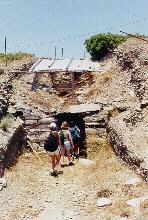 meters in diameter and has a dromos (entry "hall") 8.2 meters long.
A relieving triangle above the lintel was found but it was for purely decorative
purposes. It held numerous burials, some of whose cuttings are still visible
in the tomb floor, but now the roof has collapsed. The Greek Anastylosis
Service (with the aim of preservation, not restoration) has restored the
western half of the tholos in order to save it from further damage.
It is still one of the best preserved and most ancient examples of tholoi
in Attica, dated to around the first half of the 15th century BC.
meters in diameter and has a dromos (entry "hall") 8.2 meters long.
A relieving triangle above the lintel was found but it was for purely decorative
purposes. It held numerous burials, some of whose cuttings are still visible
in the tomb floor, but now the roof has collapsed. The Greek Anastylosis
Service (with the aim of preservation, not restoration) has restored the
western half of the tholos in order to save it from further damage.
It is still one of the best preserved and most ancient examples of tholoi
in Attica, dated to around the first half of the 15th century BC.
Nearby, approaching the lower peak of the hill, is Tholos
A. It is strange in that the interior is in an elliptical shape, 9.3
X 3.5 meters. The interior is far less stable (possibly from the shape,
i.e., not circular) and the interior is currently held up by numerous braces.
Excavations have shown that the tomb was plundered in the Mycenaean period
once and then again during the Roman period. The huge lintel blocks
which sit above the entryways, a common feature of tholos tombs, though originally
cracked in two, was snapped off in the last decade by a hefty tourist who
decided he would like to swing above the doorway (notice the lintel on the
picture to the left, and the large block on the ground beside the doorway).
Two smaller tholoi, tombs C (5 X 2 m.) and D (4 X 1.5
m.) also are found nearby (not clearly marked, but follow the goat trails).
Tomb C is particularly interesting since it was originally a 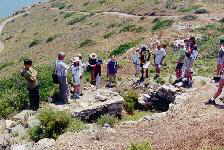 Mycenean burial, but it was apparently discovered in archaic times and,
the locals believing it to be the site of a Bronze Age warrior - most likely
from the artifacts unearthed then, established a hero cult there. It
held a complete collection of archaic pottery sherds and statuettes which
dated from the 7th century to the 5th century BC. There were a few Mycenaean
objects found under a slab which apparently had not been discovered by the
archaic Greeks. In this respect, the tomb is similar to that of Iphigenia
at Brauron, where a Mycenaean burial was also the object of cult worship
during the archaic period.
Mycenean burial, but it was apparently discovered in archaic times and,
the locals believing it to be the site of a Bronze Age warrior - most likely
from the artifacts unearthed then, established a hero cult there. It
held a complete collection of archaic pottery sherds and statuettes which
dated from the 7th century to the 5th century BC. There were a few Mycenaean
objects found under a slab which apparently had not been discovered by the
archaic Greeks. In this respect, the tomb is similar to that of Iphigenia
at Brauron, where a Mycenaean burial was also the object of cult worship
during the archaic period.
The remains of the large MH tumulus are hardly visible
but the burial inside the tumulus is near to Tomb B (roughly in between
it and Tomb A). The stones used in the tumulus are seen nearby in the
walls of a small dwelling, long since abandoned. There were also remains
of Middle Helladic houses unexcavated nearby where proof of silverworking
was found. The acropolis itself was inhabited from at least 2900 BC.
A number of graves have also been excavated in the immediate area, providing
much information on Geometric burials.
Bibliography: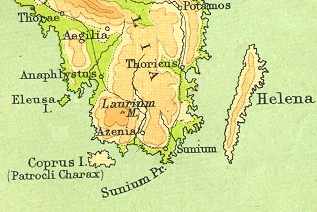
ArchDelt 1890, 159-161 (tombs
A and D).
Praktika 1893, 12-15 (tombs A
and B).
EphArch 1895, 221-226 (tombs A
and B).
Tsountas-Manatt, Mycenean Age,
383-385.
Thorikos I, 29-41 (tombs C and
D).
AchDelt 1964, chronika 80 (tomb
C).
Antiquite Classique 1965, 9-13
(tomb C).
Thorikos V, 21-102 (tomb B).
O. Pelon, Tholoi, Tumuli, et Cercles
Funeraires, 223-228 (tombs A and B).
Thorikos VIII, 14-71 (tomb A and
MH tumulus).
The Archaic and Classical Site
On the south side ot the hill, the archaic and classical
settlement has been excavated, revealing temples, a theater, and extensive
mining and metallurgical operations. The mines at Thorikos had been
mined since the third millenium BC, but not continuously. The deep
shafts now have gates prohibiting entry, but you can still peer into the
darkness and walk around the partially reconstructed settling tanks and drying
areas. During the fifth and fourth centuries BC thousdands of slaves
would have been working these mines, extracting the silver from the ore.
A large area NW of the theater, now covered with concrete, allowed the fragments
of silver to be filtered out in varying stages. The theater itself is
quite irregular (see photo) in that the Cavea is elliptical, easily seen in
the accompanying picture. 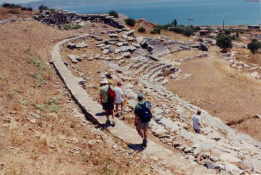 A retaining wall on the hillside gave the first theater its orchestra (5C
BC) and in the 4C BC the seating area was greatly increased in size.
A Temple of Dionysos was found at the E end of the theater, whose foundations
are also visible in the photo (far end of theater). With the increased
seating area, the theater seated around 6,000 people.
A retaining wall on the hillside gave the first theater its orchestra (5C
BC) and in the 4C BC the seating area was greatly increased in size.
A Temple of Dionysos was found at the E end of the theater, whose foundations
are also visible in the photo (far end of theater). With the increased
seating area, the theater seated around 6,000 people.
On the south side of the promentory of Agios Nikolaos
(divinding the large Bay of Thorikos to the S, also known as Portomandhri,
from the smaller bay to the N of Frankolimani), the remains were found of
the fortress which the Athenians built to help protect the Laurion mines
in 412 BC (Xenophon describes this in
Hellenica 1.2.1
).
To the SW of the town (1km), in a low-lying area, an
unfinished peripteral building usually thought to be a Doric Temple of Demeter
and Kore was unearthed (7 columns on front and 14 on each side). In
the Augustan era columns from this building were transported to the Athenian
Agora and used in the Southwest Temple
. The area is not accesible at all, by anyone, today due to current
Greek excavations.
I would like to thank Bob Bridges for his explanations
and tour of the site as well as the bibliographies below.
Bibliography of Doric building: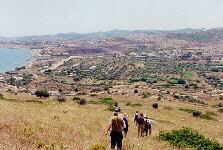
Dinsmoor Jr., 1982, 425-428 and 439.
Shear Jr., 1981, 364.
Camp, 1986, 186.
Hoff, 1988, 54-55.
Schmalz, 1994, 65-68 and 210-211.
Links:
